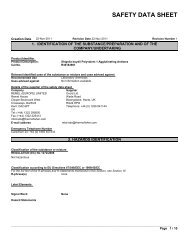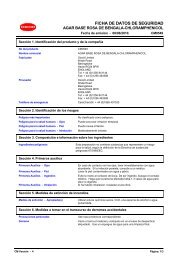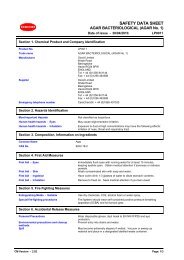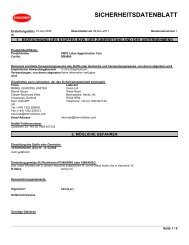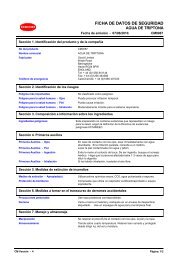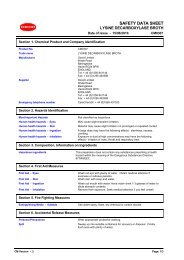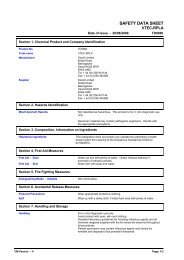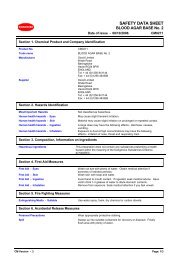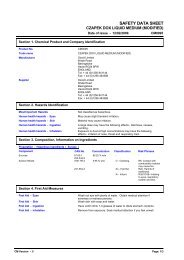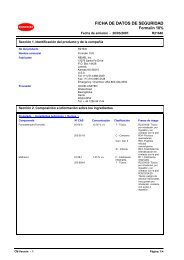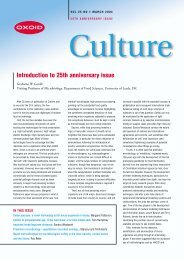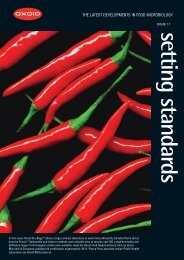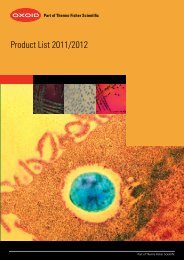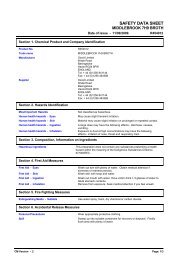IMAGEN™ Adenovirus - Oxoid
IMAGEN™ Adenovirus - Oxoid
IMAGEN™ Adenovirus - Oxoid
Create successful ePaper yourself
Turn your PDF publications into a flip-book with our unique Google optimized e-Paper software.
12.7 Test results should be interpreted in conjunction with information available from epidemiological studies,<br />
clinical assessment of the patient and other diagnostic procedures.<br />
13 EXPECTED VALUES<br />
Members of different adenovirus subgenera show distinctly different organ tropisms. However, illnesses are<br />
primarily manifested as respiratory, ocular and enteric infections. The positive isolation rate will vary,<br />
depending on the test employed, the adequacy of the specimen collection, age of the population being<br />
tested and whether the populations studied are subject to overcrowding.<br />
Isolation frequency is influenced by the severity of virus-associated diseases and also by the tendency of<br />
virus strains to cause persistent infections with shedding of infectious virus over extended periods.<br />
<strong>Adenovirus</strong>es are responsible for 5% of the acute respiratory infections in children under 4 years of age and<br />
they account for 10% of the hospitalised respiratory infections in this age group. 3,6,7 Acute haemorrhagic<br />
cystitis in children may be caused by adenoviruses. Enteric adenoviruses have been implicated in 4% to<br />
15% of all hospitalised children with viral gastroenteritis and are most prevalent in children under 3 years of<br />
age. 3,11,12<br />
Ocular infections with adenoviruses (epidemic keratoconjunctivitis and swimming pool conjunctivitis) may<br />
occur in any age group as may adenovirus infection in immunosuppressed patients. 3,8<br />
In adults, adenoviruses have been isolated from the cervix and penile lesions and from acute respiratory<br />
infection, especially in military personnel.<br />
14 SPECIFIC PERFORMANCE CHARACTERISTICS<br />
14.1 SPECIFICITY OF THE MONOCLONAL ANTIBODY WITH ADENOVIRUS SEROTYPES<br />
The monoclonal antibody utilised in this test has been shown to react with a genus specific epitope of<br />
adenovirus hexon protein which is present in all human serotypes.<br />
14.2 CLINICAL STUDIES<br />
The IMAGEN <strong>Adenovirus</strong> test was evaluated for direct use at two clinical trial centres on nasopharyngeal<br />
secretions collected from children and adults hospitalised with symptoms of respiratory infection. The test<br />
was also evaluated at a leading ophthalmic centre on conjunctival specimens from patients presenting with<br />
conjunctivitis. Three trial centres evaluated the IMAGEN <strong>Adenovirus</strong> test for the detection of adenovirus in<br />
cell culture.<br />
The trial centres tested 474 clinical respiratory specimens and 179 conjunctival specimens directly, plus 296<br />
specimens for culture confirmation. The standard tests for direct specimens were cell culture with or<br />
without indirect immunofluorescence and for culture confirmation the standard tests were indirect polyclonal<br />
antibody fluorescence or specific neutralisation.<br />
All calculations assume that the standard tests were 100% sensitive and specific. Sensitivity, specificity and<br />
predictive values were calculated as previously described. 21<br />
9/37 K6100EFG



